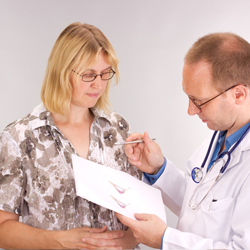Breast Reconstruction
Types of Breast Reconstruction
Dr. Fouda Neel offers the following types of breast reconstruction for women in Riyadh:
Implants

Implants are made out of silicone or saline or a combination of both, and can be inserted during or after a mastectomy. They are placed underneath the chest muscle versus on top of it, as in the case of breast augmentation.
Flaps
Dr. Fouda Neel specializes in microsurgery. During flap reconstruction, a breast is created using tissue taken from other parts of the body, such as the abdomen, back, or buttocks, or thighs, which is then transplanted to the chest by reconnecting the blood vessels to new ones in the chest region. Due to the high level of skill required for microsurgery, as well as the equipment and staff needed, these techniques are available only at specialized centers.
Fat Grafting
The breast is reconstructed using the patient’s own body fat that is collected from another area of the body.
Breast Implant-Based Reconstruction
In the past, breast reconstruction procedures relied on harvesting donor tissue from other parts of the body, which produced unfavorable scarring, long recovery times, and results that did not look entirely natural in every patient.
However, new techniques involving tissue expanders, silicone breast implants, fat transfer, and tissue regeneration with Alloderm are helping Dr. Fouda Neel achieve a soft, incredibly natural look with less scarring and less recovery. These new techniques have so radically improved the results of implant based reconstructions that harvesting donor tissue is rarely needed. In fact, Female Plastic Surgeons, when asked to choose the techniques they would want themselves, choose tissue expanders nine out of ten times. Dr. Fouda Neel works with the best breast cancer surgeons to give his patients the best and safest reconstruction possible. If you have had radiation therapy in the past, this technique may not be right for you and another form of reconstruction from your own body will be more suitable for optimal results
Combining Implant Techniques and Alloderm
The use of tissue expansion and implants can produce astounding results. This involves the use of modern tissue expanders, breast implants, fat transfer, and a regenerative tissue matrix known as Alloderm. This biological scaffolding actually allows your own tissue to grow into it, and then becomes permanently integrated into the body.
The regenerated tissue, naturally fused to the patient’s existing tissue, sets the stage for the final reconstruction.
How It Works
During a mastectomy, all of the breast tissue is removed, leaving behind a thin envelope of your own breast skin. Dr. Fouda Neel works closely with your breast surgeon to design your mastectomy and incisions for the best possible cosmetic result. Dr. Fouda Neel will elevate your chest muscle and use this in conjunction with Alloderm to create a sling or pocket to hold your tissue expander in place. Your own breast skin is then gently redraped around the new breast, minimizing stress and tension. Tissue expanders are temporary, adjustable implants that help prepare the tissue for the final reconstruction by acting as a mold for your new breast.
Once positioned under the pectoral muscle, tissue expanders are gradually inflated over a period of two to four weeks as swelling from the surgery subsides and your tissue recovers. As the tissues fuse, regenerate, and heal together, they will adopt the new shape of the tissue expander. These devices can also gradually stretch the skin and make room for larger implants if the patient desires. This method can also keep the nipple and areola intact during mastectomy to improve the overall outcome. In some cases, “nipple preservation” has provided a result so natural, it’s hard to tell the breast was ever altered.
After the skin and soft tissue has stabilized, the tissue expander is removed during a small out-patient procedure and replaced with a permanent breast implant.
As a final step, many patients will benefit from fat grafting. During this small outpatient procedure, fat is harvested from the abdomen and lower body through small 3 mm incisions. The fat is then injected into and around the breast. As your own tissue grows into the breast it helps to create soft, smooth, and natural contours. Combining all of these treatments, Dr. Fouda Neel is able to “bioengineer” a very soft, natural-looking breast and bust contour. Tissue expanders, unlike when tissue is harvested from other areas of the patient’s body, require less time in the operating room, less time spent recovering, and leaves no unattractive donor site scars.
Life-Changing Benefits of Expert Breast Reconstruction
Patients who have undergone the tissue expansion method of breast reconstruction have been thrilled with the benefits they have experienced. Traditional reconstructive surgery can take an incredible emotional and physical toll, but the tissue expansion method is less invasive, and provides incredibly natural-looking results. Many patients say that they feel whole and beautiful at the completion of their treatment.
Flaps for Breast Reconstruction
Advanced Technique for Superior Results
DIEP Flap Breast Reconstruction
- The DIEP flap technique is a method of breast reconstruction similar to TRAM flap surgery. However, the DIEP (Deep Inferior Epigastric Perforator) method affords the patient a unique set of advantages that distinguishes it from other breast reconstruction procedures that use living tissue. Because the DIEP flap technique is such an advanced form of surgery, only a select group of surgeons possess the education, training, and experience to successfully and safely perform the procedure. Dr. Fouda Neel is among the few surgeons in the country whom patients can trust to perform the DIEP technique.
- During traditional breast reconstruction procedures – most notably those using the TRAM flap and latissimus flap techniques – skin, muscle, and fatty tissue are taken from the donor area. While the new breast can be created using only skin and fatty tissue, the skin tissue needs blood to stay alive. However, the vessels that connect the skin to the vital blood source run through the muscle tissue, thus necessitating its removal along with the skin and fat.
- The DIEP flap technique represents a considerable improvement in medical technology and technique. During the DIEP flap procedure, skin and fat tissues are separated from the abdominal area. But, unlike the traditional breast reconstruction methods, the muscle tissue and abdominal wall fascia (connective tissue) are left intact and in place.
- After the DIEP flap (skin, fat, and perforator vessels from the abdominal donor site) is transferred to the mastectomy site, the blood vessels are carefully reattached under a microscope to a new blood source at the reconstruction site.
Advantages of the DIEP Flap
- The distinctive feature of the DIEP flap technique – the preservation of the abdominal muscles and connective tissue – greatly reduces the risks of hernia and abdominal wall weakness. Patients who undergo the DIEP flap procedure at our practice typically experience less pain and discomfort. Recovery time for patients is usually shorter, meaning a quicker return to normal, everyday activities. The residual scar from the surgery is no different than that from the TRAM flap surgery, and patients still receive the added benefit of abdominal contouring that looks similar to the results of a tummy tuck.
Experience is Critical for the Best Cosmetic Results
Dr. Fouda Neel performs the most complex breast reconstruction surgeries and more types of procedures.
We perform a high volume of these surgeries and are constantly finding ways to make them even better.
These microvascular reconstructive surgeries allow Dr. Fouda Neel to manage compromised breast tissue that may have been injured by radiation. Preserving as much of the natural look and feel of a woman’s breasts as possible is also of great concern to our surgeons.
Using Fat Grafting for Breast Reconstruction
In addition, by trying to give women the look and feel of an actual breast, using creative techniques such as fat grafting, also known as lipofilling or fat transfer. Fat can be taken from another part of your body, possibly the abdomen or somewhere on your buttocks, through liposuction. The fat will be purified and carefully layered within the new breast to create the desired shape. Dr. Fouda Neel is experienced in these techniques.
State-of-the-Art Surgical Techniques for Better Breast Sensation
Our reconstructive surgeons are using innovative techniques that give patients the best and most natural results. One such technique is the nerve regeneration procedure that enables tissue transplanted from the abdomen to have sensation when sculpted into her newly created breast.
Read about breast reconstruction in Arabic.
Back
Riyadh Clinic
Dr. Omar Fouda Neel, FRCSC, FACS
King Abdullah Rd, King Salman Neighborhood
Riyadh 12444, Saudi Arabia
+(966) 57-858-7777
Saturday through Thursday: 1 p.m. to 9 p.m.
Friday: Closed












